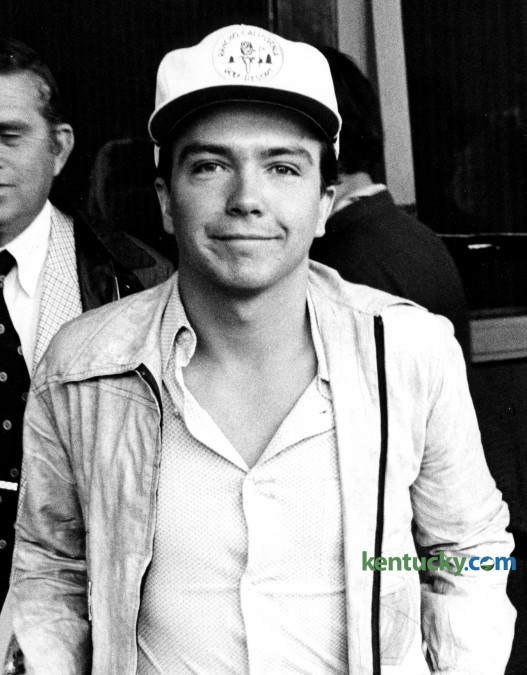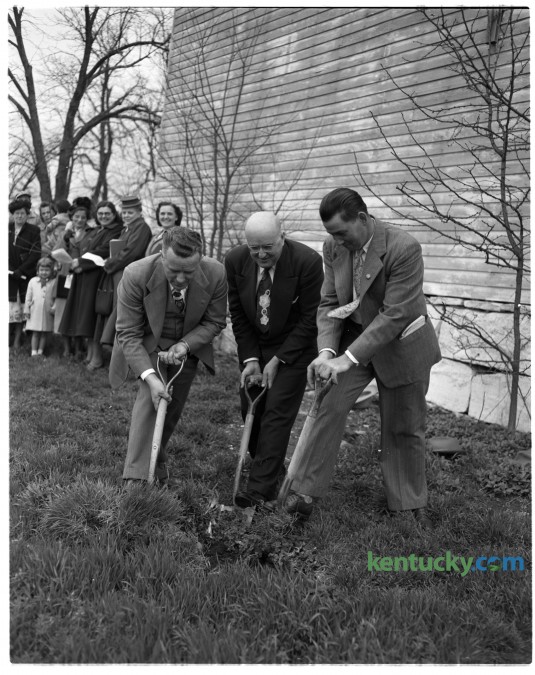September 15, 2025
Future UK coach Claiborne as UK player, 1946
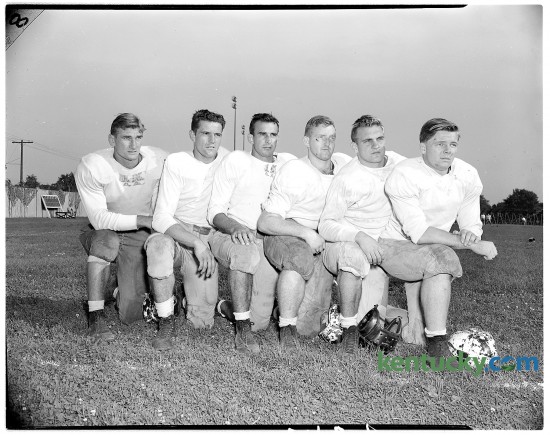
Newcomers on the University of Kentucky football team in September 1946 included future UK coach Jerry Claiborne, second from right. Claiborne played three years as halfback under Paul “Bear” Bryant. He went on to become the head coach at Virginia Tech (1961–1970) and Maryland (1972–1981) before returning to UK in 1982. In his eight seasons as head coach, he led the Wildcats to two bowl games and a record of 41-46-3. He was inducted into the College Football Hall of Fame in 2000. From left, Harry Ulinski, Nick Odlivak, John Ciepalich, J. C. Williams, Claiborne and Dick Holway. Published in the Lexington Leader on Sept. 17, 1946.
Commonwealth Stadium’s first game, 1973
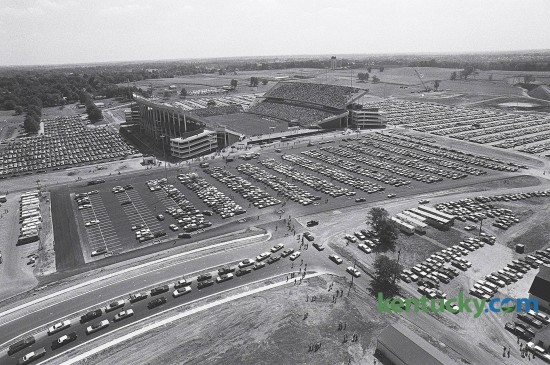
Traffic outside Commonwealth Stadium on Sept. 15, 1973, before the inaugural game at the new home of the Wildcats. After 48 years at Stoll Field, the Cats won their first game at Commonwealth, 31-24 over Virginia Tech. The stadium and parking lot are on what was once part of the UK Experimental Station Farm Grounds. Commonwealth Stadium had a capacity of 57,800 and cost $12 million to build — a tenth of the cost of the 2015 renovation, which added suites to the south side. In 1999 both end zones were enclosed during a $27.6 million expansion that raised capacity to 67,942. In May 2017, it was announced that Commonwealth Stadium will be known as Kroger Field, per a deal struck between the university, UK Athletics and marketing partner JMI Sports. Click on the image for a closer look and click here to see more images from our archives of the home of the Wildcats.
Advance registration at UK, 1986
Kennedy’s Book Store, 1982
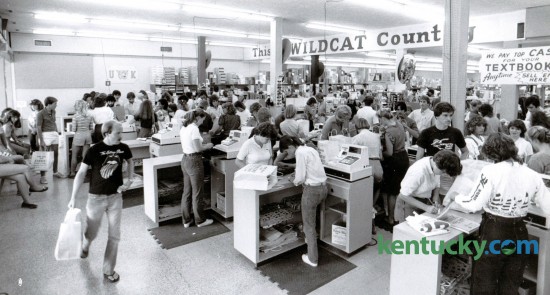
In late August of 1982 University of Kentucky students returned to campus for the fall semester. Students crowded the Kennedy’s Bookstore at the south corner of South Limestone and Winslow streets on August 24, 1982. The textbook and fan merchandise store that has been a fixture beside the University of Kentucky campus since 1950, will close after the 2017 fall semester ends. The family opened a small store in an old corner grocery building at 541 South Limestone Street in 1950. By 1953, Kennedy’s had moved to its present corner, which it shared with a bowling alley, barbershop, pool hall, gas station and snack shop. As the bookstore grew and prospered, the family-run business gradually acquired all of the property. In 1964, UK took over operation of the Campus Book Store, which moved to the Student Center across from Kennedy’s and was renamed the University Bookstore. Since 1984, UK has outsourced the store to several companies, including Kennedy’s from 2001-2006. It currently is run by Barnes & Noble. Kennedy’s Book Store changed its name to Kennedy’s Wildcat Den in 2013 to emphasize that it sold much more than books. At the height of Kennedy’s success, the family owned a half-dozen college stores and fan shops in Kentucky and nearby states and ran Transylvania University’s book store. Kennedy’s now has one other business, a UK fan merchandise store in London, which will continue operating for the near-future. Photo by Gary Landers
Canine crosswalk guard, 1958
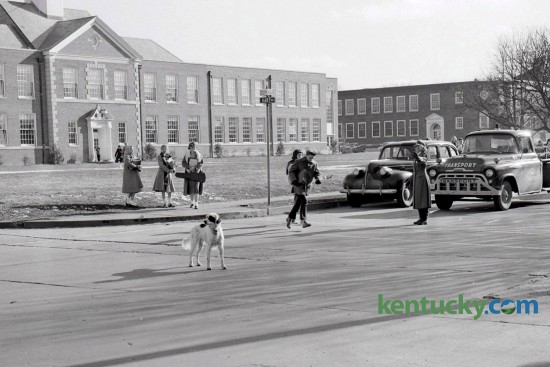
The Lone Ranger, a 4-year-old English Setter owned by Dr. J. O. Van Meter, helped Mrs. Ann Bryant with traffic supervision in 1958 in front of Cassidy Elementary on Tates Creek Road. Morton Junior High, now Morton Middle School, is on the right next to Cassidy. Published in the Lexington Herald on Jan. 7, 1958.
David Cassidy at Keeneland sale, 1972
Tobacco cutting, 1982
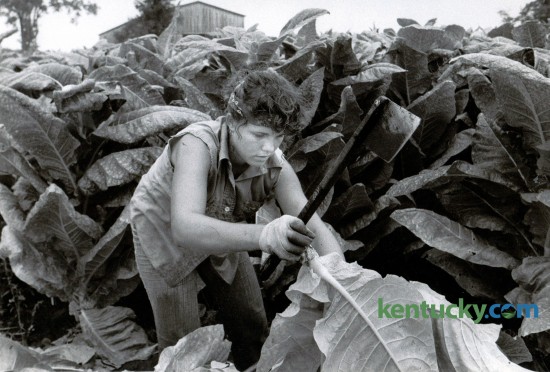
Tammie McKenney cut 500 sticks of tobacco in five hours during the women’s speed-cutting event on Aug. 30, 1982, at the Bluegrass Tobacco Festival in Scott County. Officials thought her feat to be an unofficial women’s world record. McKenney, 17, was a high school senior from Mount Zion. Photo by Charles Bertram | Staff
Happy Chandler, new commissioner of baseball, 1945
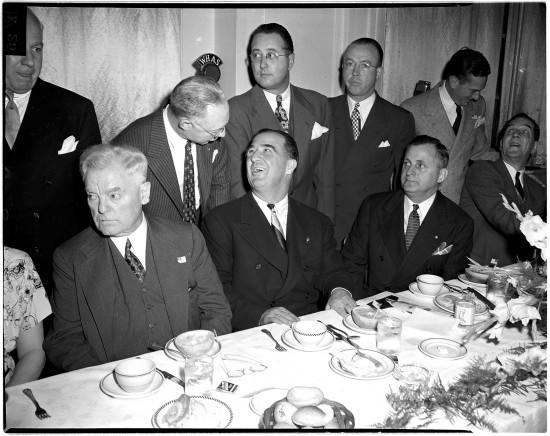
Above, the Lexington Co-Operative Club held a testimonial dinner to U.S. Sen. A.B. (Happy) Chandler in April 1945 at the Lafayette Hotel. Chandler was being honored as the newly appointed commissioner of major league baseball. Chandler is seated at the center of the table, turning his head to speak to a man standing behind him. Seated at right, next to Chandler, is Adolph Abraham, president of the Co-Operative Club. Standing, from center to left, are William E. Benswanger, president of the Pittsburgh Pirates; William DeWitt, general manager of the St. Louis Browns; and Earl Hilligan, representing Will Harridge, president of the American League. The identities of the other men in the photo are unknown. Chandler was twice governor of Kentucky and served in the U.S. Senate. He resigned his Senate seat to become the second commissioner of baseball. During his tenure, from 1945 to 1951, he approved Jackie Robinson’s contract with the Brooklyn Dodgers, helping to integrate baseball, and he established the first pension fund for players. Owners became upset with Chandler and did not renew his contract.
Filming “The Asphalt Jungle,” 1949
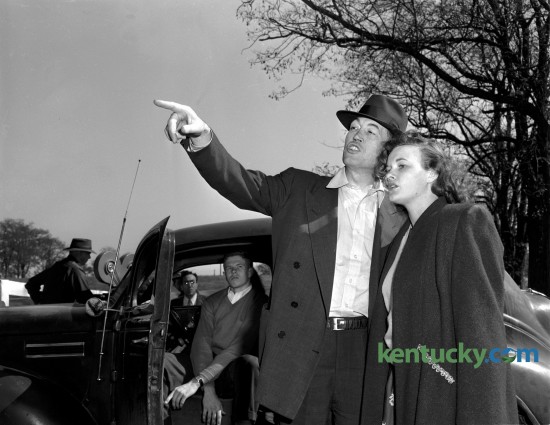
Movie director John Huston talked to actress Jean Hagen during the filming of the final scene of The Asphalt Jungle in 1949. The film also starred Sterling Hayden, and parts of it were filmed on the Ben Eubank farm on Briar Hill Road in Lexington. Published in the Lexington Leader Oct. 14, 1949. The Asphalt Jungle was a 1950 film noir based on the 1949 novel of the same name by W. R. Burnett.


